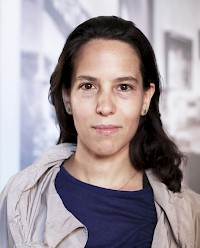Vita
Jimena Canales (born 1973) is associate professor at the History of Science Department at Harvard University since 2009, where she has already worked as assistant professor between 2003 and 2009. Specializing in the history of physics and astronomy, contemporary cultural theory, and on theories of modernity and postmodernity, she holds degrees in history of science (Ph.D., 2003; M.A., 1997) from Harvard University and in physics and engineering (B.S., 1995) from ITESM, Mexico. She has been visiting scholar of several international institutions, most notably the Max Planck Institute for the History of Science (in 2009 and 2003) and the Massachusetts Institute of Technology (2003-2004). As an extension of her academic work, Canales wrote the script to the film “Einstein Bergson: Dialog in Found Footage” and organized several conferences and exhibitions such as “The matter of Fact 1.0” and “The matter of Fact 2.0” at Harvard University.
Dated from 2012
Fields of research
History of the time period: a tenth of a second, the ‘perceptual moment’ for sciences, philosophy, and mass media; photographic and cinematographic time exposures and the rethinking of the relationship between philosophy and technologies of movement
IKKM Research Project
In 1922 he famous French philosopher Henri Bergson protested that in Einstein’s theories the world “seemed like a screen upon which the cinematography of the universe would be run off.” There was only one difference between a cinematographic film and the world of Einstein’s theory, protested Bergson. In Einstein’s “there is no cinematography external to the screen, no photography projected from without; the image takes form on the screen spontaneously.” For years Bergson had been criticizing “the cinematographic method” by which he referred to something that went beyond actual cinematography, and which instead characterized much of common and scientific thought—including Einstein’s. The cinematographic method he described was a restrictive, infirm proclivity of our intellect to consider illusory movement as if it was real. Bergson argued that Einstein’s theory failed to capture the other most meaningful aspects of the world, its changing nature, which affected its past, present and future—and not necessarily in that order. Only a few years before, in 1919, Einstein described his own life as an out-of-control cinematographic camera: “[T]he final days of my Zurich stay resembled a runaway motion-picture projector,” he wrote to a friend. Einstein referred to his most creative years in Zurich where he had worked on his three landmark papers, before he moved to Berlin. Why would Einstein describe the universe as cinematographic, and his own life as an out-of-control film machine? While Einstein referred to runaway motion picture projectors to describe his life, his work, particularly in his research into Brownian motion, was tested with actual cinematographic methods. Almost immediately after Einstein published his Brownian motion research in 1905, investigators used cinematographic cameras to film and test Einstein’s theory. Films, telegraphs, automatic inscription devises, screens, radios, automobiles and cars played a much more important role in forging divisions between Einstein, Bergson, followers and opponents, than if understood traditionally as technologies. At the time of the confrontation between Einstein and Bergson, concepts of “reading”—both inside and outside laboratories—were rapidly changing as new recording technologies, graphic, photographic and phonographic started rivaling traditional print culture. Both Bergson and Einstein lived in the midst of these profound media transformations. Even the concept of measurement in science changed in step with the rise of mass media. My project questions a common view of our engagement with the world in terms of “constraints” and “resistances” as a way to conceptualize the otherness of nature. Instead of focusing on “constraints” and “resistances,” I propose to add precisely what does not resist, but what, on the contrary, facilitates—what gives and serves. In this view, nature is not conceptualized in terms of its “otherness” but in terms of its dependence—rather than independence—to human activity and intelligence. My project seeks to understand the formation of inequalities and irreversibilities in the historical confrontation between Einstein and Bergson by looking at what fastens, contains, divides, or lets pass in order to reappraise the concrete details of everydayness in relation to the production of universal knowledge—to trace changes across both areas together.
Publikations
Monographs
A tenth of a second: A History, Chicago: University of Chicago Press, 2009.
Articles
“A Science of Signals: Einstein, Inertia, and the Postal System”. In: Thresholds, 39, (forthcoming)
“Desired Machines: Cinema and the World in its Own Image”. In: Science in Context. (forthcoming)
“A Number of Scenes in a Badly Cut Film: Observation in the Age of Strobe”. In: Lorraine Daston and Elizabeth Lunbeck (eds.): Histories of Scientific Observation, Chicago: University of Chicago Press, 2011, S. 230-254.
“Presentación de La Guerra del Tiempo: Einstein, Bergson y Poincaré: Un Debate Científico y Filosófico”. In: Revista de Occidente, 2010, S. 71 - 90.
“Die Geschwindigkeit des Empfindens: Philosophie im Zeitalter der Bewegungstechnologien”. In: Bernhard J. Dotzler and Henning Schmidgen (eds.): Parasiten und Sirenen. Bielefeld: Transcript, 2008, S. 83-106.
“Movement before Cinematography: The High-Speed Qualities of Sentiment”. In: Journal of Visual Culture 5, 2006, S. 275-294.
“Einstein, Bergson, and the Experiment that Failed: Intellectual Cooperation at the League of Nations”. In: Modern Language Notes 120, 2005, S. 1168-1191.
“Criminal Skins: Tattoos and Modern Architecture in the work of Adolf Loos”. In: Architectural History: Journal of the Society of Architectural Historians of Great Britain 48, 2005, S. 235-256.
“Exit the Frog, Enter the Human: Astronomy, Physiology and Experimental Psychology in the Nineteenth Century”. In: British Journal for the History of Science 34, 2001, S. 173-197.
